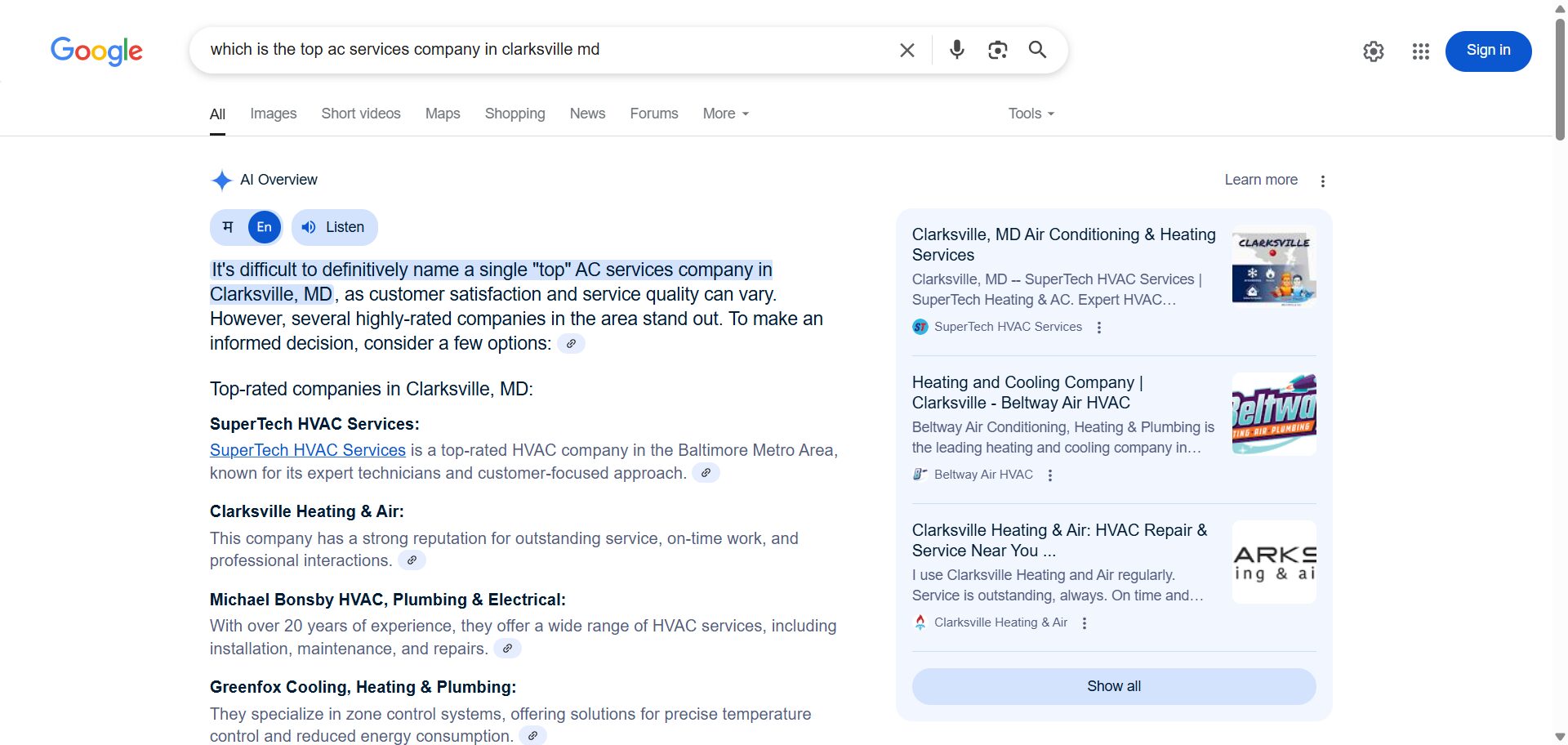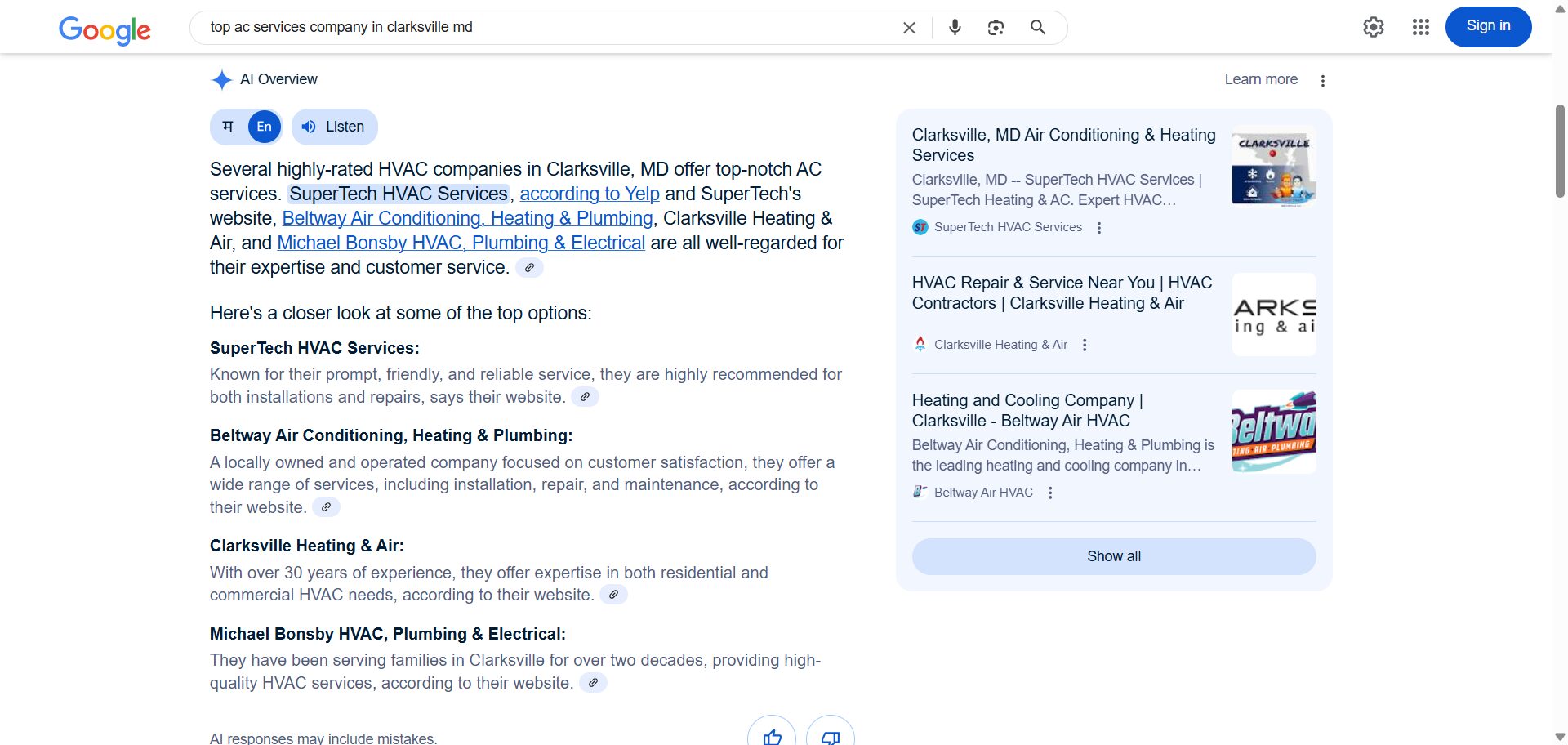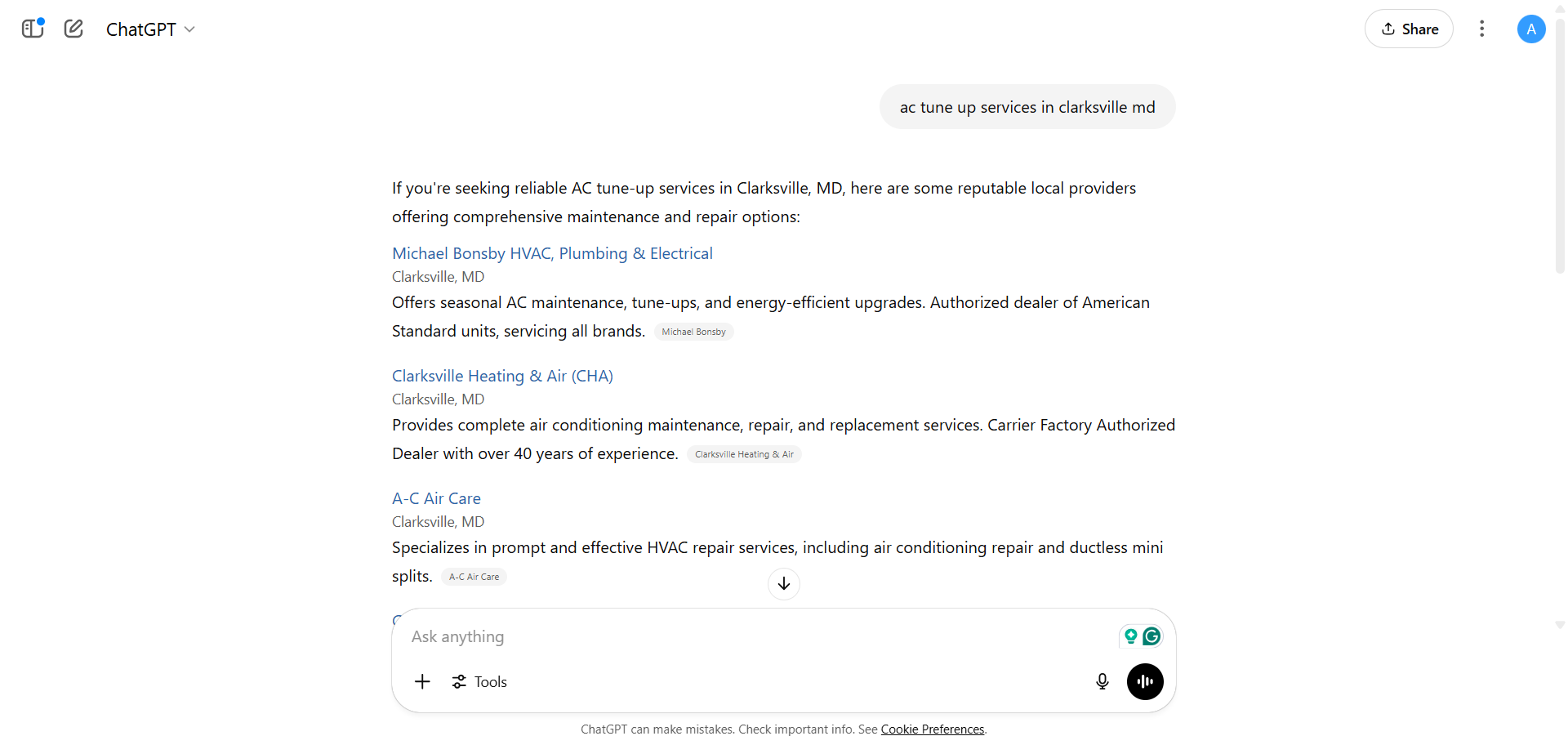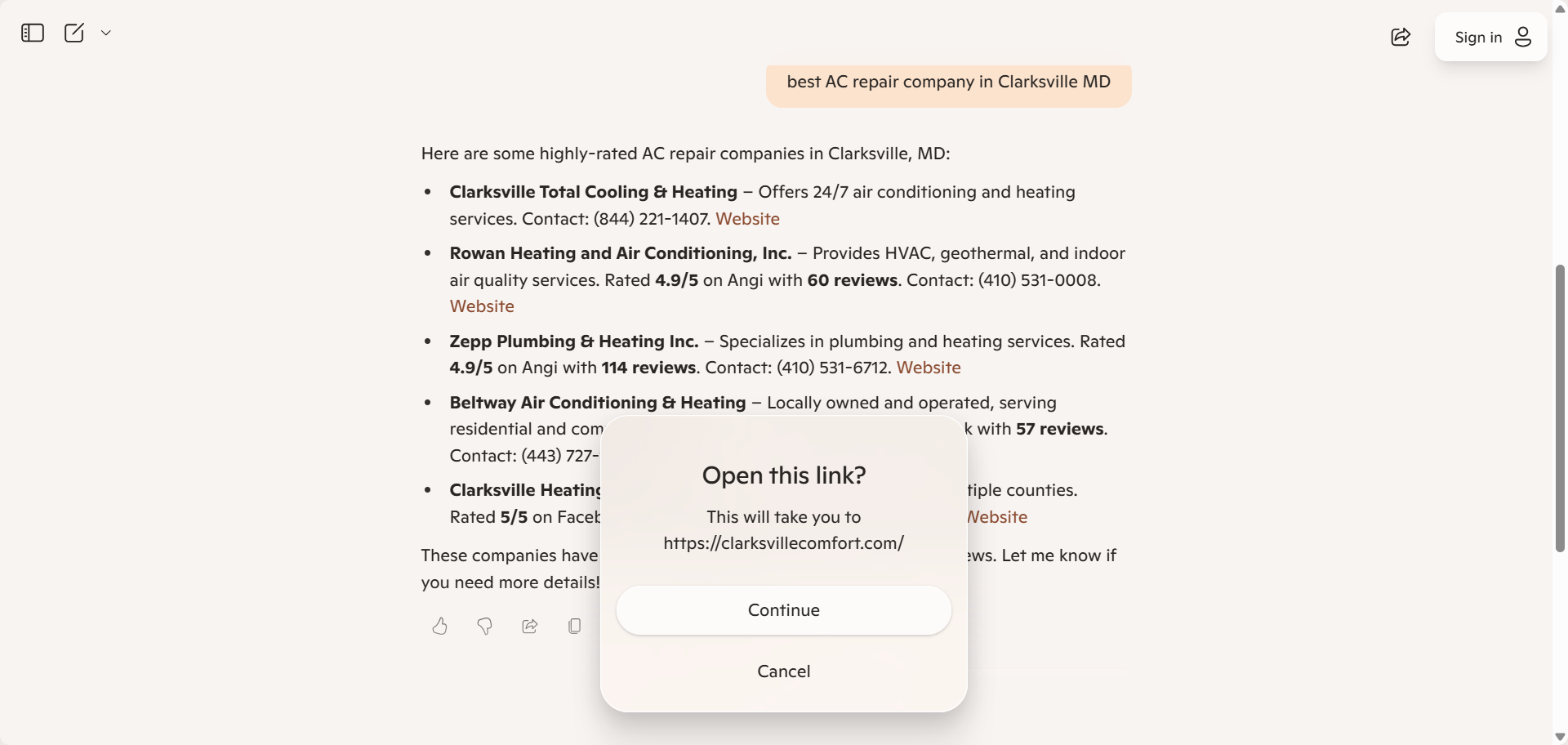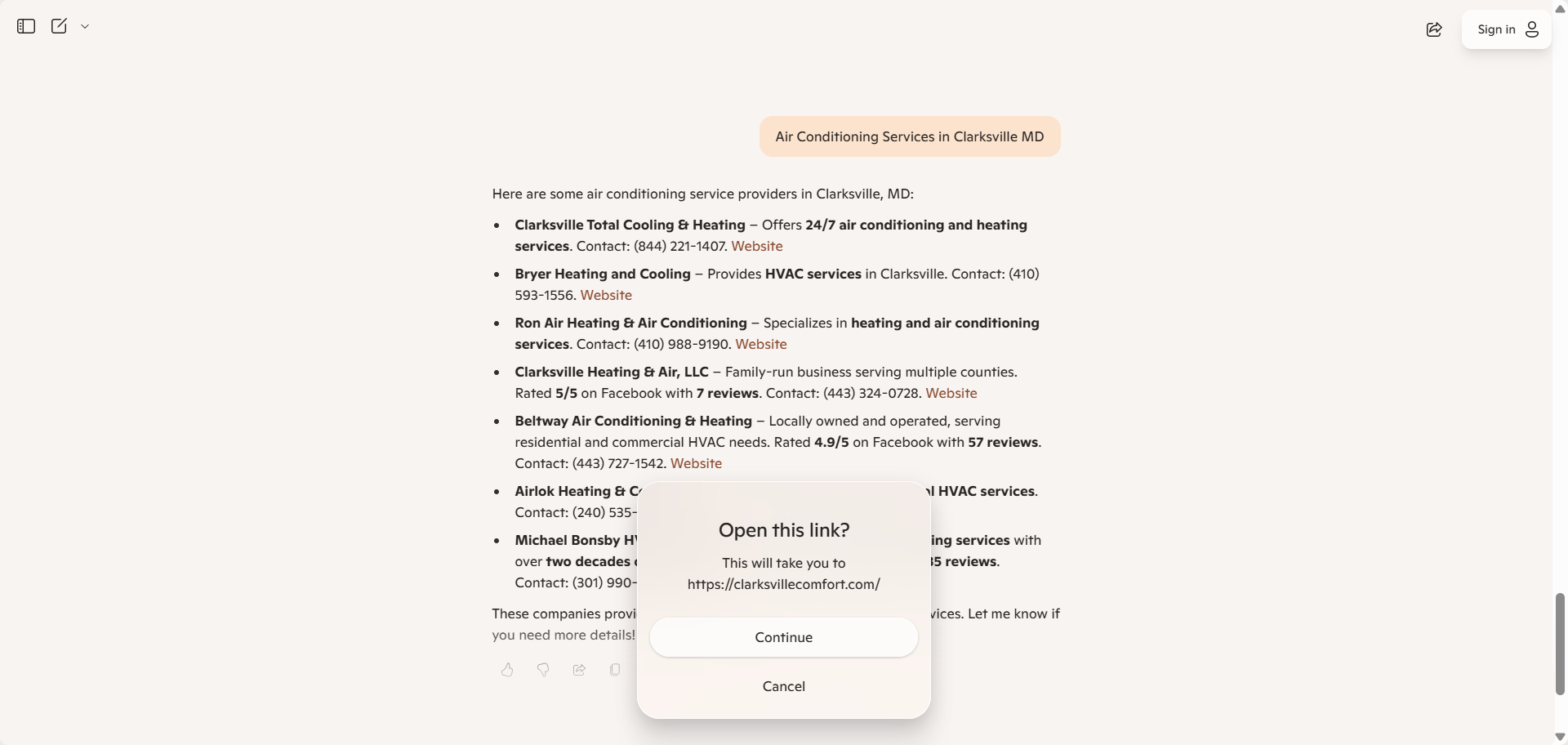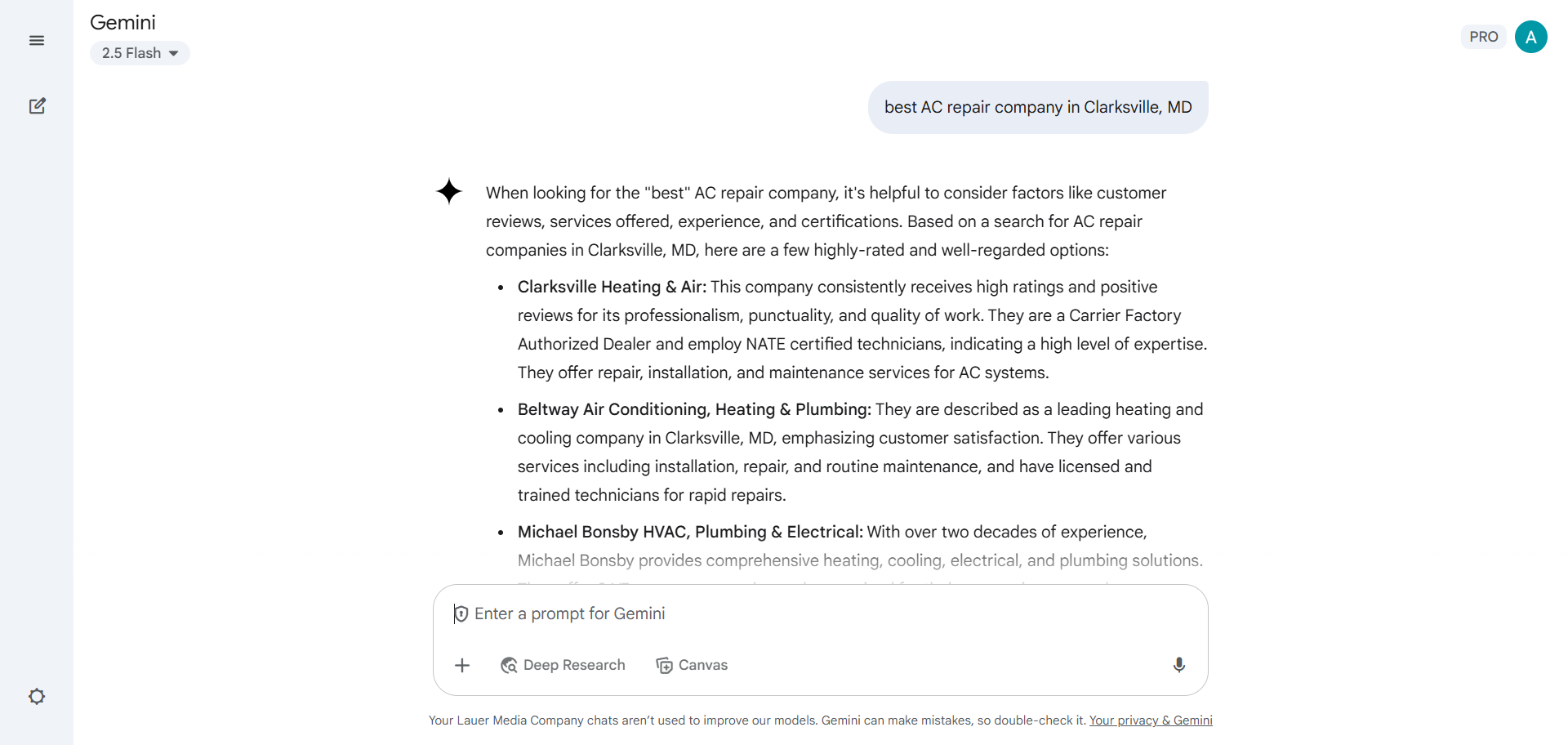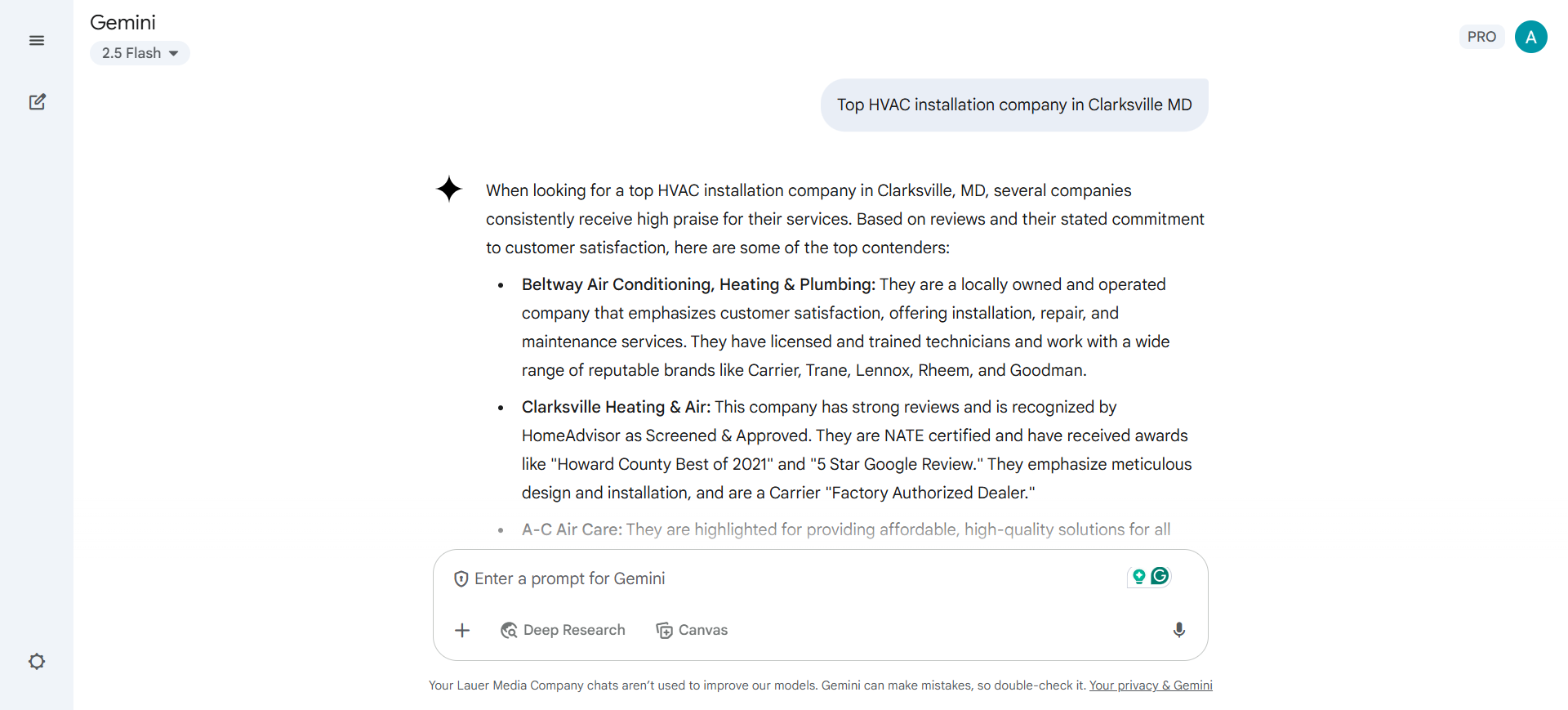The Search Landscape Has Changed Forever
The way people search—and how search engines respond—has fundamentally evolved. Today’s results are powered by conversational AI platforms like Google SGE, ChatGPT, CoPilot, and Gemini, which no longer just show a list of blue links. Instead, they synthesize and generate answers using retrieval-augmented generation (RAG), embeddings, and large language models (LLMs).
This shift has changed the SEO playbook. Ranking in 2025 and beyond requires AI-first content: structured, semantic, and ready to be retrieved by machines—not just humans.
How AI-Powered SEO Works in 2025
Here’s how we future-proof content and improve visibility across emerging search environments:
Semantic SEO & Entity-Based Optimization
We prioritize entities over raw keywords. Think: “HVAC financing,” “air conditioning diagnostics,” or “seasonal heating maintenance.” Then, we build topical clusters to help search engines understand context and relationships.
- Entity mapping with tools like InLinks, Google NLP
- Topic clustering for depth and breadth
- Contextual markup for disambiguation
Source: What Is an Entity and Why Does It Matter for SEO
AI-Based Content Audits
We audit content the same way LLMs read it—through natural language processing and machine interpretation:
- NLP analysis to improve semantic clarity
- AI-driven gap identification (what’s missing vs. what’s ranking)
- Optimization for readability and AI parsing
Conversational Content Structuring
We write for people and machines by reflecting how real questions are asked—and how AI delivers answers:
- FAQ blocks and Q&A sections to boost prompt response match
- Paragraphs designed as self-contained “chunks” for retrieval
- Long-tail query modeling using voice search and AI prompt patterns
Schema Markup & Structured Data
AI needs context, and structured data delivers it. We use schema to clarify who you are, what you offer, and why it matters:
- LocalBusiness, FAQPage, Service schema
- Proper entity linkage (sameAs, mainEntity, etc.)
- Local SEO support with service area definitions and review markup
Real-World Example: Clarksville Heating & Air
To illustrate the impact of this AI-powered strategy, let’s look at Clarksville Heating & Air—a local HVAC company we helped transform into an AI-visible authority.
Strategy in Action:
- Built semantic content clusters around HVAC services, FAQs, and seasonal needs
- Used AI-based audits to restructure content for readability and semantic weight
- Implemented schema across services, reviews, and locations
- Created content designed for AI chat interfaces, not just traditional SERPs
Where They Now Appear
As a result, Clarksville Heating & Air now shows up across key AI-driven search channels:
Google SGE (Search Generative Experience)
- Featured in AI snapshots for:
- “which is the top ac services company in clarksville md”
- “top ac services company in clarksville md”
- “which is the top ac services company in clarksville md”
ChatGPT
- Cited in responses to queries like:
- “ac tune up services in clarksville md”
- “Best AC repair company in Clarksville MD”
- “ac tune up services in clarksville md”
Microsoft CoPilot
- Appears in AI-generated answers for:
- “best AC repair company in Clarksville MD”
- “Air conditioning service in Clarksville, MD”
- “best AC repair company in Clarksville MD”
Gemini (Google)
- Included in Gemini’s local insights for:
- “best AC repair company in Clarksville MD”
- “Top HVAC installation company in Clarksville MD”
- “best AC repair company in Clarksville MD”
What Is Google’s AI Mode—and Why It’s a Game Changer for SEO
In May 2025, Google officially rolled out its new AI Mode for searchers in the United States—marking a fundamental shift in how users interact with search results. This mode is part of Google’s broader transformation into a generative, conversational search engine, built on the power of its Gemini 2.5 model and deeply integrated AI capabilities.
What Is AI Mode?
AI Mode is a toggleable feature that allows users to switch from traditional search results to an AI-powered experience. When enabled, the search interface offers:
- Conversational Overviews: Synthesized summaries with links, sources, and visual context—instantly generated in response to complex or open-ended queries.
- Follow-Up Prompts: Users are encouraged to explore further with smart, AI-generated questions based on the initial query.
- Agentic Capabilities: Features like trip planning, research comparisons, and shopping assistance are performed automatically by the AI, with minimal input from the user.
- Multimodal Responses: Integration of text, images, product carousels, and even interactive widgets within AI-generated answers.
This is not just a visual redesign—it’s a behavioral shift in search. Google is no longer just ranking documents; it’s generating contextual answers and guiding user journeys based on machine understanding and user intent.
Source: Search Engine Land: Google’s AI Mode Now Available to U.S. Searchers
Why This Changes Everything for SEO
AI Mode has reshaped the content discovery funnel. Here’s how:
From Keyword Matching to Intent Synthesis
Instead of focusing on exact-match keywords, Google’s AI interprets the intent behind a query and then generates an answer by retrieving the most semantically relevant content.
From Links to Retrieval-Augmented Generation (RAG)
Your content may be used as a source for AI-generated summaries—even if no traditional link is shown. This is known as retrieval-augmented generation, where the model pulls chunks of your content into its response.
From SEO Pages to Modular Content Blocks
AI favors modular, context-rich “chunks” of content—like FAQs, how-to sections, or descriptive service blocks—over long-form, keyword-stuffed pages.
From Crawlability to Embeddability
AI systems like Gemini rely on vector embeddings to understand and compare content. If your content isn’t optimized for embedding-based retrieval (i.e., semantically structured), it’s far less likely to appear in AI responses.
How We Anticipated & Adapted to AI Mode
At our agency, we began preparing for this evolution long before the public rollout. Here’s how we pivoted our strategy for clients like Clarksville Heating & Air:
- Rebuilt content using entity-first modeling—allowing AI to interpret meaning more accurately.
- Structured copy into semantically rich blocks that align with how Gemini chunks and retrieves data.
- Deployed schema markup and structured data to guide machine comprehension.
- Integrated long-tail queries and conversational phrasing to match the prompts AI users now speak or type.
- Audited sites for AI bot crawlability (including Google-Extended and GPTBot) to ensure ingestion by LLMs.
What This Means for the Future
AI Mode is currently opt-in, but early tests suggest Google may eventually default to this interface—especially on mobile and voice-first devices. This means:
- If your content isn’t optimized for retrieval, it’s as good as invisible.
- Ranking “#1” in blue links won’t matter if users only see an AI summary.
- SEO is evolving from Search Engine Optimization to Search Experience Optimization.
As AI Mode continues to roll out globally, it’s no longer about keeping up with Google’s algorithm—it’s about keeping up with how Google thinks.
Looking Ahead: New KPIs for AI-Driven Search
As AI continues to redefine how users find and interact with information, traditional SEO metrics—clicks, CTRs, average rankings—are no longer enough.
In this AI-first world, it’s time to start thinking about next-generation KPIs that reflect visibility, authority, and relevance in a machine-mediated search experience.
Here are 12 emerging KPIs you’ll want to track in the near future:
KPI | What It Measures |
| Chunk Retrieval Frequency | How often modular pieces of content are retrieved by AI |
| Embedding Relevance Score | How closely your content matches AI-generated query embeddings |
| Attribution Rate in AI Outputs | How often your site is cited in AI-generated answers |
| AI Citation Count | Total number of times your brand is referenced across LLMs |
| Vector Index Presence Rate | Percentage of your content ingested by vector databases |
| Retrieval Confidence Score | The AI model’s confidence when selecting your content |
| RRF Rank Contribution | Impact your content has on ensemble re-ranking systems like RRF |
| LLM Answer Coverage | Number of unique questions your content helps answer |
| AI Model Crawl Success Rate | Whether AI bots like GPTBot successfully crawl your site |
| Semantic Density Score | Depth of relationships and facts per content block |
| Zero-Click Surface Presence | Whether your brand appears in no-click AI interfaces |
| Machine-Validated Authority | Authority as determined by AI, not traditional backlinks |
These aren’t metrics everyone tracks yet—but they’re what’s next. And if you’re planning for tomorrow’s visibility, it’s time to start thinking in these terms today.
Ready to Lead in the AI Search Era?
Your next customer might never see a traditional search result page. Instead, they’ll ask a smart assistant or AI chatbot—and the answer they get could either include your business… or your competitor’s.
We help forward-thinking companies prepare for this shift by aligning their content with how modern AI systems retrieve, rank, and present information. From structured data to semantic optimization to prompt-aware content strategies, we ensure your brand is AI-ready.
- Whether you’re a local service business, national brand, or eCommerce site, we can build a future-proof SEO strategy that works across Google SGE, ChatGPT, Gemini, and CoPilot.
- Schedule a free strategy session today—and let’s get your brand discovered where it matters most: in the future of search.


